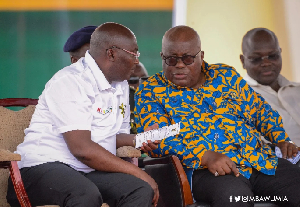Impromptu performances, like rolling thunder, daily shake the grassy hill at Musikfest’s Handwerkplatz. There, a master drum-maker and his assistant demonstrate their handiwork- wood-sculpted drums fit for a king of the Asante people in the African nation of Ghana.
James Acheampong, 42, is one in a long line of royal drum-makers. The smell, the feel of newly carved cordia wood and the steady, driving rhythm of drums shaped his childhood. Sculpting richly detailed wood creations is his passion, he said, there was never another path in life. ”I love it,” he said. ”It is part of me.”
An equally spirited performer, Acheampong is a drummer and dancer in the tradition of his mother, grandfather and great-grandfather before him.
”You can’t be a good carver if you don’t know anything about drumming,” he said while demonstrating the playing technique for a handful of onlookers, including Donna Honigman of Bethlehem, an animal therapist and music lover. The intensity of the drums she described as ‘’spiritual.”
”It shakes your soul,” she said. ”The drum is the heartbeat of music.”
Every drum has a different sound, said Acheampong. The deeper, richer-sounding drums are considered male, and the higher-pitched ones female. In the hands of a skillful drummer, their booming sound proved an efficient means of communication between villages long before the telephone.
The king would dispatch drummers to telegraph messages to elders in outlying villages, said Acheampong. Both wars and great celebrations were announced with drums.
For years, his family drum-making business catered exclusively to Ghana’s elite, its kings and chiefs, each with their signature design, he said. Now, Acheampong’s creations are spread across the globe, most of them carved in a studio back home in Ghana with the help of a cadre of students at the Centre for National Culture in the city of Kumasi.
Drums for the king are sculpted exclusively by Acheampong, not his students. One of his creations includes a 5-foot, carved drum with gold inlay and other finery, he said.
As often as twice a year Acheampong sets up shop at art and music festivals in the United States, where he draws inspiration from other artists. This year, after spending time at a jazz festival in New Orleans, he landed at Musikfest.
Along with his assistant and student of nine years, Kofi Atta, 36, Acheampong brings a small sampling of tools — some of which have been in his family for generations — including a machete and a hand-crafted adze for smoothing rough-cut wood.
Some of his creations - which take as little as a week or as long as a year to complete — are on display under a white tent where he and Atta toil, unperturbed by the heat, surrounded by piles of feathery wood chips. Their work quickly caught the attention of another Musikfest drum-maker, Conrad Kubiak.
Kubiak, whose work is displayed on this year’s Musikfest poster, said Acheampong’s drums are ”underpriced” and prohibitively labor-intensive with hand-cast metal fittings — a practice that he said is unheard of in the United States, where labor is expensive.
”I’d have to charge $20,000 for a drum like that,” said Kubiak of Wrightstown Township in Bucks County.
Acheampong’s work ranges in price from about $20 for small, wooden sculptures to $2,500 for some drums, his assistant said.
Acheampong will host a workshop for children on Saturday at 2 p.m. at Handwerkplatz, where he will demonstrate carving, drumming and dancing. He enjoys teaching. His own four children, raised in what Acheampong calls ”the computer age,” occasionally come to his studio to watch their father. He wonders if any will follow in his footsteps.
If they chose another path, Acheampong would be the last in a line of master drum-makers dating back more than 300 years. He isn’t troubled by the notion. His students at the Centre for National Culture will bear the torch.
The tradition, he said, would merely pass ”from one family to another.”
















